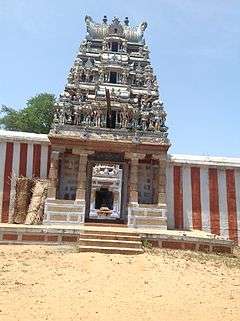Arjuneswarar
| Arjuneswarar Temple | |
|---|---|
|
Arjuneswarar Koil East | |
 Arjuneswarar Temple Kadathur, Location in Tamil Nadu | |
| Name | |
| Proper name | Arjuneswarar Koil |
| Tamil | கோமதி அம்மன் உடனுரை அர்ச்சுனேஸ்வரர் திருக்கோவில் |
| Geography | |
| Coordinates | 10°37′14″N 77°23′56″E / 10.62056°N 77.39889°ECoordinates: 10°37′14″N 77°23′56″E / 10.62056°N 77.39889°E |
| Country | India |
| State | Tamil Nadu |
| District | Tirupur |
| Location | Kadathur |
| Elevation | 325 m (1,066 ft) |
| Culture | |
| Primary deity | Arjuneswarar (Shiva) |
| Consort | Gomathi Amman |
| Direction and posture | East |
| Temple tank | Amaravathi River |
| Architecture | |
| Architectural styles | Dravidian architecture |
| History and governance | |
| Creator | Cholas |
Arjuneswarar Koil is situated on the banks of Amaravathi River in Kadathur. This has the tallest Swayambhu Lingam in the Kongu Region. Swayambhu Lingams manifest on its own i.e. not made by man. They appear suddenly or mysteriously without any human efforts.[1]
The main deity, Moolavar in this temple is Arjuneswarar. The alternate names for the Moolavar are Marudheesar, Marudhudaiyar and Marundheesar. The consort of the main deity is worshiped in the name of Gomathi Amman.
History
This lingam was buried under the roots of an Arjuna tree for a long time. Hence we can see the impressions of the roots of the tree on the body of the lingam. During the Mahabharatha time Pandavas had lived in the areas around Dharapuram a nearby town. It is a belief that during that period, Arjuna had worshipped this Linga. This is one of the reason's why the deity has been named Arjuneswarar.
In the nearby village called Karathozhuvu, there were lots of cattle. These used to visit the nearby village of Kaniyur which had lot of fruit bearing trees. On their way back to Karathozhuvu, these cattle were seen discharging the milk in their udder on the root of a Marudha Tree. The king of those time ordered the tree to be cut. When the root was cut, blood was seen oozing from the root and the Linga was discovered.. The King removed the ring from his finger and arrested the blood. This can be still seen on the body of the Linga.
The temple was built during the Chola reign. The temple is being maintained by donations and grants from many people, who are native to this region. This temple is administered by the HR&CE of Tamil Nadu. The maintenance of the temple is done by the Arjuneswarar Trust.
Special Features
Amaravathy River flows around the temple. In the morning sun's rays fall on the river and get reflected on to the Lingam. Two times in a year Sun's rays directly fall on the Lingam. The Gomathi Amman temple is on the right side of the Lord which is a special feature.[2] Just like in Kashi, there is a cremation ground right in front of the Deity's sanctum.
The Gomathi Amman Sannithi is to the right of Moolavar. There is a large mound (Tamil: புற்று) near the entrance to the Amman Sannithi. Earlier, there was a wall between the Sivan and Ambal Sannithi.
The temple has a marble statue of Sri Dakshinamurthy, which was brought from Kashi. The temple has a separate sannithi for Lord Saneeshwara.
Beliefs
Because the Linga had been under an Marudha tree for a long time, the water used for bathing the lingam is supposed to contain healing properties. During the Kongu Chola Vikrama Cholan III's (1302 A.D) rule Vikrama Cholan Tirubhuvana Singhan had diabetes. He worshipped Arjuneswarar and donated lands to the temple. He got cured and hence there is a belief that praying to Arjuneswarar cures one of diabetes.[3]
References
- ↑ Swaminathan, Santanam. "Science behind Swayambhu Lingams". Retrieved 3 November 2013.
- ↑ "Vellimani October 18". Dinamani. Retrieved 3 November 2013.
- ↑ "Vellimani October 18". Dinamani. Retrieved 3 November 2013.
External links
In this Temple by worshiping Lord Shiva and visiting temple on Sunday 4.30 to 6 will clear the obstacles in Marriage. In the Temple History once there lived a King and his daughter marriage was met drastic struggle. By Visiting this Temple those barriers in marriage were removed and her marriage happened.
